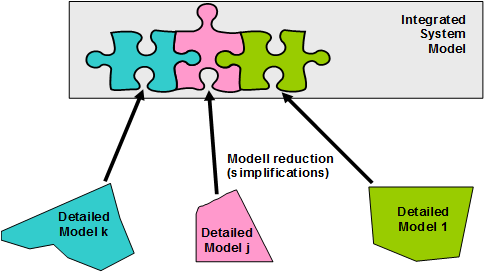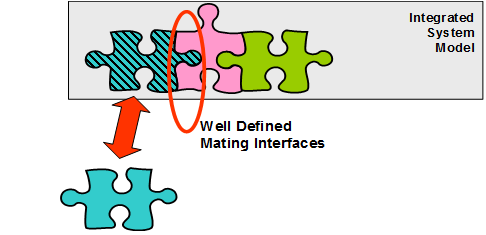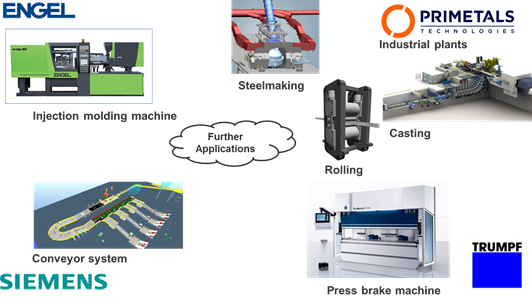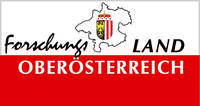ACCM Multi-Firm-Project
System Models for Mechatronic Design
SyMMDe (2013-2017)
Objectives
SyMMDe is aiming- at deriving advanced approaches for the development of mechatronic systems and
- at finding innovative mechatronic solution concepts for the mechatronization of production systems.
The goals of SyMMDe are
- Methods for a systematic development of system models for an improved system view
- Methods for a transparent view on internal design processes
- Efficient coupling and integration of discipline-specific models that usually serve as the basis for CAx-tools, to models of a super-ordinate system.
- Definition of a proper (hierarchical) model structure, of proper interfaces (regarding, e.g., physical properties, CAx tools) between the different model types


Methodology
- Model based mechatronic design approaches, i.e., by design related modeling and simulation with special emphasis on the system view of the design object, i.e. the object under design.
- Advanced approaches for conceptual and preliminary design relying on “concept models” at an appropriate system level representing the essential information including a significant system view of the design object.
- Modular structure of models (modular model architecture, model base, hierarchical structure of models) that allows for the configuration of system models from a library of sub-models and interface models.
- Methods for the decision, which information (e.g. which properties and which of their quantifying parameters) should be included in the system model and which in the sub-models.
- Methods and approaches such as DSM (Design Structure Matrices), reduced order modeling, multi-layer modeling in CAx systems, parametric design, design automation, knowledge based engineering, Model Integrated Mechatronics (MIM), Property-Driven Development/Design (PDD), Function-Oriented Design (FOD) etc. will support the methods and tasks as described above.
Expected Results
Advanced approaches for mechatronic design of certain classes of products including a framework of methods for- system modeling, thus significantly improving the system view,
- the integration of isolated „stand alone models“ to system-level models,
- the design of suitable interfaces between models,
- improved consistency between models and traceability of changes
- establishing modular structures of compatible (and exchangeable) models for “plug and play“,
- establishing hierarchical models with different “granularity” (from very high to low detail)
Applications

Partners
| Scientific Partners | |
|---|---|
| JKU, Institute of Mechatronic Design and Production, Linz, Austria http://www.jku.at/imdp/ |
|
| JKU, Institute of Machine Design and Hydraulic Drives, Linz, Austria http://www.jku.at/imh |
|
| LCM, Linz Center of Mechatronics GmbH http://www.lcm.at/ |
|
| Company Partners | |
| Engel Austria GmbH http://www.engelglobal.com |
|
| Siemens AG Corporate Technology http://www.siemens.com |
|
| Primetals Technologies Austria GmbH http://www.primetals.com |
|
 |
Trumpf Maschinen Austria GmbH & Co KG http://www.trumpf.com |
Contact
Dr. Peter HehenbergerInstitut für Mechatronische Produktentwicklung und Fertigung
(Institute of Mechatronic Design and Production)
Johannes Kepler University Linz
Altenbergerstr. 69, A-4040 LINZ, AUSTRIA
Phone: ++43-732-2468-6554
Fax: ++43-732-2468-6542
peter.hehenberger (at) jku.at
Funding Organisations
 The K2 - Competence Centre ACCM is funded in the framework of the COMET - Competence Centers for Excellent Technologies by the Federal Ministry for Transport, Innovation and Technology (BMVIT), the Federal Ministry of Economy, Family and Youth (BMWFJ), the Provincial Government of Upper Austria and the scientific partners.
The K2 - Competence Centre ACCM is funded in the framework of the COMET - Competence Centers for Excellent Technologies by the Federal Ministry for Transport, Innovation and Technology (BMVIT), the Federal Ministry of Economy, Family and Youth (BMWFJ), the Provincial Government of Upper Austria and the scientific partners.
The COMET programme is conducted by FFG.
The strategic objectives of COMET are: developing new expertise by initiating and supporting long-term research co-operations between science and industry in toplevel research, and establishing and securing the technological leadership of companies. By advancing and bundling existing strengths and by integrating international research expertise Austria is to be strengthened as a research location for the long term.




